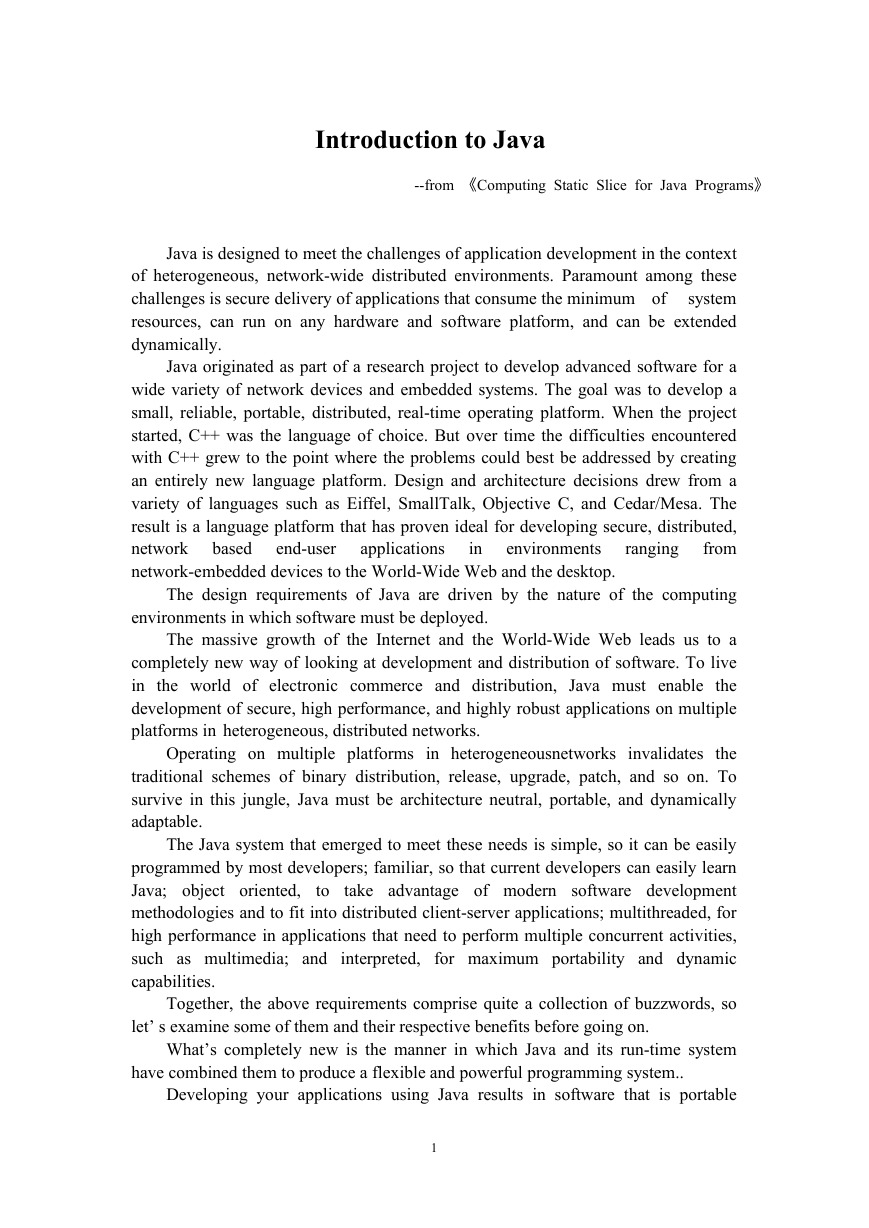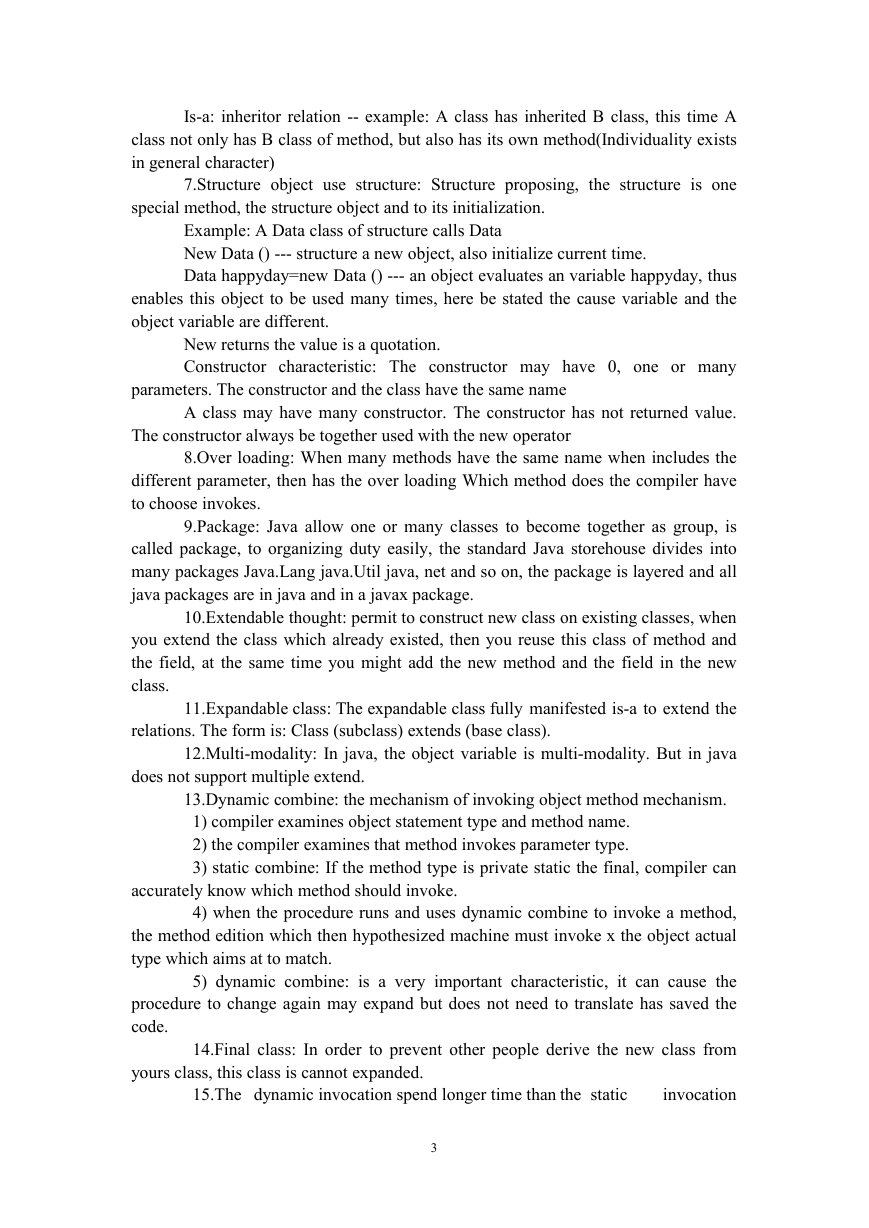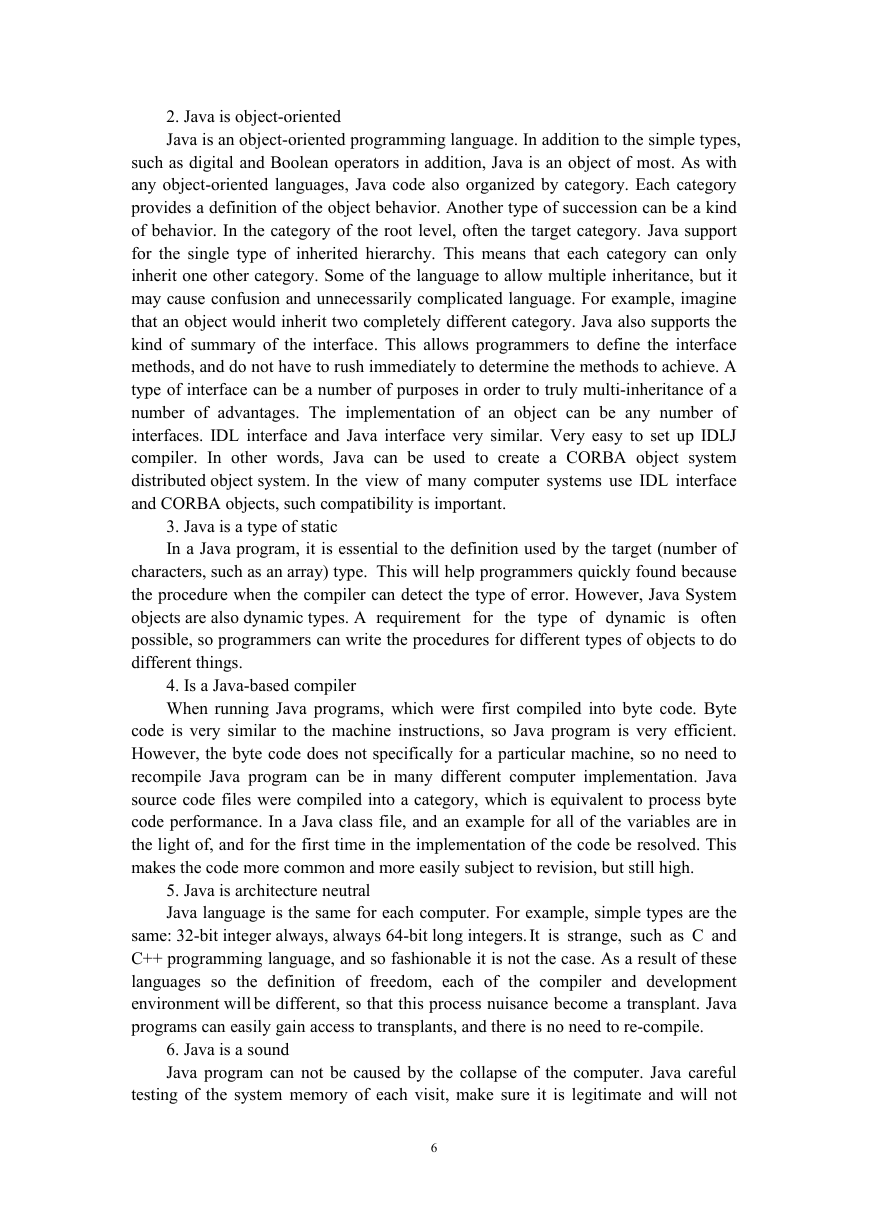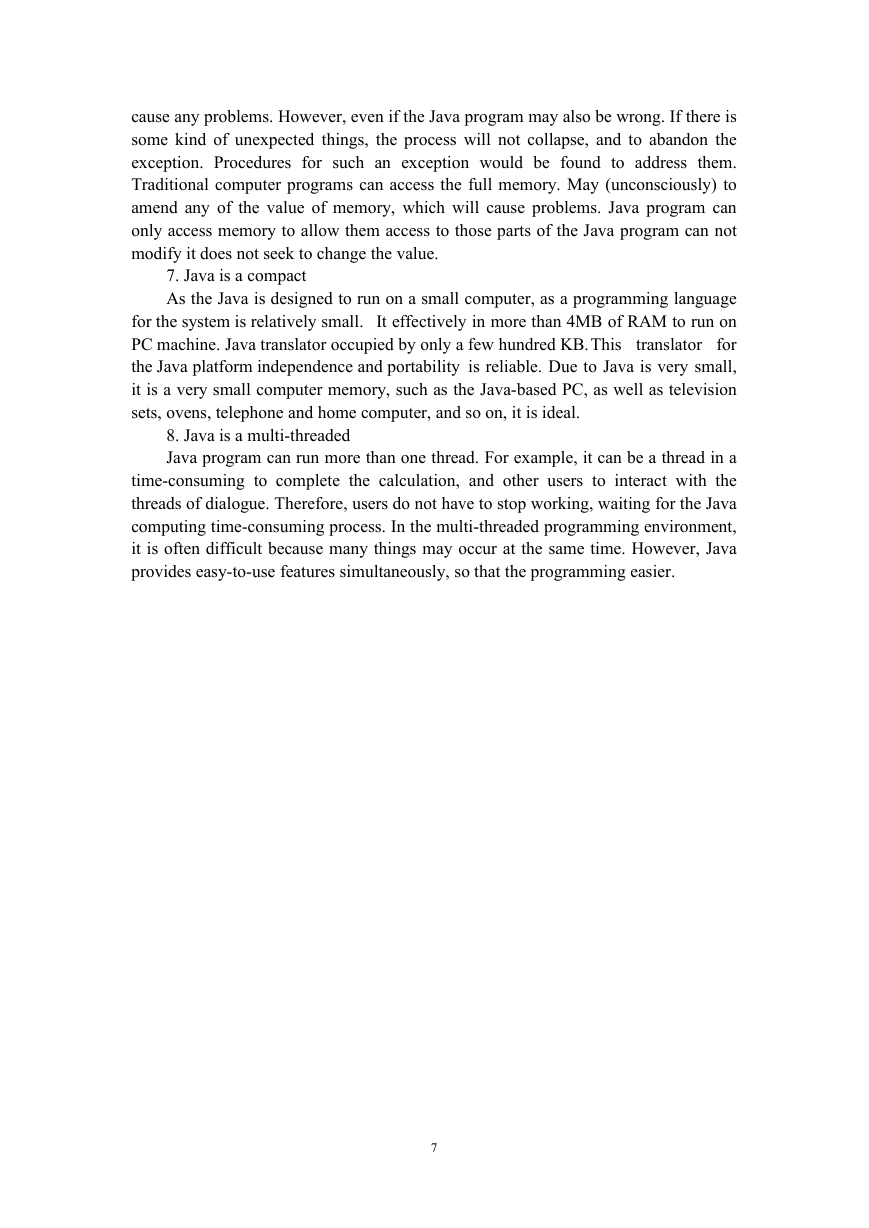Introduction to Java
--from 《Computing Static Slice for Java Programs》
Java is designed to meet the challenges of application development in the context
of heterogeneous, network-wide distributed environments. Paramount among these
challenges is secure delivery of applications that consume the minimum of
system
resources, can run on any hardware and software platform, and can be extended
dynamically.
Java originated as part of a research project to develop advanced software for a
wide variety of network devices and embedded systems. The goal was to develop a
small, reliable, portable, distributed, real-time operating platform. When the project
started, C++ was the language of choice. But over time the difficulties encountered
with C++ grew to the point where the problems could best be addressed by creating
an entirely new language platform. Design and architecture decisions drew from a
variety of languages such as Eiffel, SmallTalk, Objective C, and Cedar/Mesa. The
result is a language platform that has proven ideal for developing secure, distributed,
network
from
network-embedded devices to the World-Wide Web and the desktop.
environments
applications
end-user
ranging
based
in
The design requirements of Java are driven by the nature of the computing
environments in which software must be deployed.
The massive growth of the Internet and the World-Wide Web leads us to a
completely new way of looking at development and distribution of software. To live
in the world of electronic commerce and distribution, Java must enable the
development of secure, high performance, and highly robust applications on multiple
platforms in heterogeneous, distributed networks.
Operating on multiple platforms in heterogeneousnetworks invalidates the
traditional schemes of binary distribution, release, upgrade, patch, and so on. To
survive in this jungle, Java must be architecture neutral, portable, and dynamically
adaptable.
The Java system that emerged to meet these needs is simple, so it can be easily
programmed by most developers; familiar, so that current developers can easily learn
Java; object oriented,
to take advantage of modern software development
methodologies and to fit into distributed client-server applications; multithreaded, for
high performance in applications that need to perform multiple concurrent activities,
such as multimedia; and interpreted,
for maximum portability and dynamic
capabilities.
Together, the above requirements comprise quite a collection of buzzwords, so
let’ s examine some of them and their respective benefits before going on.
What’s completely new is the manner in which Java and its run-time system
have combined them to produce a flexible and powerful programming system..
Developing your applications using Java results in software that is portable
1
�
across multiple machine architectures, operating systems, and graphical user
interfaces, secure, and high performance, With Java, your job as a software developer
is much easier—you focus your full attention on the end goal of shipping innovative
products on time, based on the solid foundation of Java. The better way to develop
software is here, now, brought to you by the Java language platform.
Very dynamic languages like Lisp, TCL, and SmallTalk are often used for
prototyping. One of the reasons for their success at this is that they are very robust —
you don’t have to worry about freeing or corrupting memory.
Similarly, programmers can be relatively fearless about dealing with memory
when programming in Java, The garbage collection system makes the programmer’s
job vastly easier; with the burden of memory management taken off the programmer’s
shoulders, storage allocation errors go away. Another reason commonly given that
languages like Lisp, TCL, and SmallTalk are good for prototyping is that they don’t
require you to pin down decisions early on—these languages are semantically rich.
Java has exactly the opposite property: it forces you to make explicit choices.
Along with these choices come a lot of assistance— you can write method
invocations and, if you get something wrong, you get told about it at compile time.
You don’t have to worry about method invocation error.
The Java beginner must grasp 30 basic concepts
Basic concept
1.In OOP the only relations is what
the object’s interface, such as the
computer seller he leaves alone internal structure of electrical source, but he is only
concerned about that whether the power will be supplied to you, also so long as know
can or not but is not how and why. All procedures are make up of certain attribute and
the behavior object, the different object visit invokes through the function invocation,
between the object all intercommunion are invoke through the method invocation, By
object data encapsulation, enhances reuse rate very much..
2.In OOP the most important thought is class, the class is the template, is a
blueprint, construct an object from a class, namely construct an instance of the class.
3.Encapsulation: is that combines the data and the behavior in a package and
hides the data the realization process to the object user, in an object data is called its
instance field.
4.Through expands a class to obtain a new class is called inheritance, but all
classes are constructed by the object super root class of expansion, super root class of
as follows can make the introduction.
5.Object 3 principal characteristics
Behavior--- explained this object can make what.
Tate--- when the object exerts the method object reflection.
Dentity--- and other similar behavior objects discrimination symbols.
Each object has only indentity and among three characteristics they affect
mutually.
6.Relations among classes:
Use-a: Dependent relation
Has-a: Polymerization relation
2
�
Is-a: inheritor relation -- example: A class has inherited B class, this time A
class not only has B class of method, but also has its own method(Individuality exists
in general character)
7.Structure object use structure: Structure proposing, the structure is one
special method, the structure object and to its initialization.
Example: A Data class of structure calls Data
New Data () --- structure a new object, also initialize current time.
Data happyday=new Data () --- an object evaluates an variable happyday, thus
enables this object to be used many times, here be stated the cause variable and the
object variable are different.
New returns the value is a quotation.
Constructor characteristic: The constructor may have 0, one or many
parameters. The constructor and the class have the same name
A class may have many constructor. The constructor has not returned value.
The constructor always be together used with the new operator
8.Over loading: When many methods have the same name when includes the
different parameter, then has the over loading Which method does the compiler have
to choose invokes.
9.Package: Java allow one or many classes to become together as group, is
called package, to organizing duty easily, the standard Java storehouse divides into
many packages Java.Lang java.Util java, net and so on, the package is layered and all
java packages are in java and in a javax package.
10.Extendable thought: permit to construct new class on existing classes, when
you extend the class which already existed, then you reuse this class of method and
the field, at the same time you might add the new method and the field in the new
class.
11.Expandable class: The expandable class fully manifested is-a to extend the
relations. The form is: Class (subclass) extends (base class).
12.Multi-modality: In java, the object variable is multi-modality. But in java
does not support multiple extend.
13.Dynamic combine: the mechanism of invoking object method mechanism.
1) compiler examines object statement type and method name.
2) the compiler examines that method invokes parameter type.
3) static combine: If the method type is private static the final, compiler can
accurately know which method should invoke.
4) when the procedure runs and uses dynamic combine to invoke a method,
the method edition which then hypothesized machine must invoke x the object actual
type which aims at to match.
5) dynamic combine: is a very important characteristic, it can cause the
procedure to change again may expand but does not need to translate has saved the
code.
14.Final class: In order to prevent other people derive the new class from
yours class, this class is cannot expanded.
15.The dynamic invocation spend longer time than the static
invocation
3
�
expenditure.
define is abstract.
16.Abstract class: Stipulated or many abstract methods class of itself must
Example: Public abstract string getDescripition
17.In Java each class is be extended by object class.
18.equal and toString method in object class .
Equal uses in testing an object is whether equal with another object.
ToString returns to represent this object the string of character, each class
can nearly over loading this method, in order to returns to the current condition the
correct expression.(The toString method is a very important method)
19.General programming: Any class of type all values all may replace with
a object class of variable.
20.The array tabulates: The ArrayList dynamic array tabulates, is a class of
storehouse, defines in java. In uitl package, but automatic control array size.
21.In class and class of object, getclass method returns to the class type an
example, when the procedure start contains can increase in the main method class,
hypothesized confidential increase all classes which he needs, each increase class all
must increase the class which it needs.
22.The class: class might dynamic operate the java code for the compilation
the procedure to provide the formidable function reflection,
this function was
JavaBeans is specially useful, the use reflected Java to be able to support the VB
programmer to be familiar with the use the tool.
procedure of analysis class ability is called the reflector, in Java to provide
reflection mechanism is
this function the package to call Java.Lang. The reflect
extremely formidable.
1) when run analysis class ability.
2) when run searches observes a class of object.
3) realizes the general array operation code.
4) provides the method object.
But this mechanism mainly aims at the tool but not the application and the
procedure.
In the reflection mechanism most important part is that permits class that
you inspect structure. With to API includes:
Java.Lang.Reflect.Field returns to the field.
Java.Reflect.Method
Java.Lang.Reflect.Constructor
Method pointer: Java does not have the method pointer, makes a method
address another method, may invoke it in behind, but the interface is the better
solution.
returns to the parameter.
returns to the method.
23.interface: should showing class could do what but not to assign how to
do, a class may realize one or many interfaces.
24.The interface is not a class, but is to conforms to a interface request class
of set of standard.
If realizes a interface to need 2 steps:
4
�
1) the statement class needs to realize assigns the interface.
2) provides in the interface all methods definition.
Stated a class realizes a interface to need to use the implements key words.
Class actionB implements Comparable its actionb needs to provide the
CompareTo method, the interface is not the class, cannot use a new example interface.
25.A class only then a super class, but a class can realize many interfaces.
In a Java important interface: Cloneable
26.The interface and call-back :to programs a commonly used pattern is
call-back, in the pattern, you may refer when this class of pattern settled specific time
occurs returns to adjusts on the object the method.
Example:ActionListener interface monitor.
Similar API includes:
Java.Swing.JOptionPane
Java.Swing.Timer
Java.Awt.Tookit
27.Object clone:The clone method is a object protection method, this meant
your code cannot simple invoke it.
28.Inner class an inner class definition is the definition in another class.
The reason is:
1) an inner class object can visit founds its object realization, including
2) about other classes in the same package in that, inner class can be hided.
3) the anonymous inner class may the very convenient definition accent.
4) uses the category to be possible the extremely convenient compilation
private data.
event driver.
29.Agent class (proxy):
1) appointing all codes that interfaces request
2) all methods (toString equals) that object class define
30.Data type: Java is kind of emphasizing type language, each variable all
must be declared its types at first, in java altogether has 8 basic types . four kinds are
the long, two kinds are the float, one is the char, being used in the Unicode code char,
Boolean.
programming language features,
1. java is simple
Java and C++ are very similar, but much simpler. All
For example, Java does not overload operator,
the high-level
is not absolutely necessary have been deleted.
the title of the document,
pre-processing, computing pointer, the structure of the joint, multi-dimensional array,
templates and implicit type conversion.If you know a little C, C++ or Pascal, you will
soon master Java. Here is a simple procedure Java Hello World:
public class HelloInternet (
public static void main (String args []) (
System.out.println ("HelloIn-ternet!")
)
)
5
�
2. Java is object-oriented
Java is an object-oriented programming language. In addition to the simple types,
such as digital and Boolean operators in addition, Java is an object of most. As with
any object-oriented languages, Java code also organized by category. Each category
provides a definition of the object behavior. Another type of succession can be a kind
of behavior. In the category of the root level, often the target category. Java support
for the single type of inherited hierarchy. This means that each category can only
inherit one other category. Some of the language to allow multiple inheritance, but it
may cause confusion and unnecessarily complicated language. For example, imagine
that an object would inherit two completely different category. Java also supports the
kind of summary of the interface. This allows programmers to define the interface
methods, and do not have to rush immediately to determine the methods to achieve. A
type of interface can be a number of purposes in order to truly multi-inheritance of a
number of advantages. The implementation of an object can be any number of
interfaces. IDL interface and Java interface very similar. Very easy to set up IDLJ
compiler. In other words, Java can be used to create a CORBA object system
distributed object system. In the view of many computer systems use IDL interface
and CORBA objects, such compatibility is important.
3. Java is a type of static
In a Java program, it is essential to the definition used by the target (number of
characters, such as an array) type. This will help programmers quickly found because
the procedure when the compiler can detect the type of error. However, Java System
objects are also dynamic types. A requirement
the type of dynamic is often
possible, so programmers can write the procedures for different types of objects to do
different things.
for
4. Is a Java-based compiler
When running Java programs, which were first compiled into byte code. Byte
code is very similar to the machine instructions, so Java program is very efficient.
However, the byte code does not specifically for a particular machine, so no need to
recompile Java program can be in many different computer implementation. Java
source code files were compiled into a category, which is equivalent to process byte
code performance. In a Java class file, and an example for all of the variables are in
the light of, and for the first time in the implementation of the code be resolved. This
makes the code more common and more easily subject to revision, but still high.
5. Java is architecture neutral
Java language is the same for each computer. For example, simple types are the
same: 32-bit integer always, always 64-bit long integers.It is strange, such as C and
C++ programming language, and so fashionable it is not the case. As a result of these
languages so the definition of freedom, each of the compiler and development
environment will be different, so that this process nuisance become a transplant. Java
programs can easily gain access to transplants, and there is no need to re-compile.
6. Java is a sound
Java program can not be caused by the collapse of the computer. Java careful
testing of the system memory of each visit, make sure it is legitimate and will not
6
�
cause any problems. However, even if the Java program may also be wrong. If there is
some kind of unexpected things, the process will not collapse, and to abandon the
exception. Procedures for such an exception would be found to address them.
Traditional computer programs can access the full memory. May (unconsciously) to
amend any of the value of memory, which will cause problems. Java program can
only access memory to allow them access to those parts of the Java program can not
modify it does not seek to change the value.
8. Java is a multi-threaded
Java program can run more than one thread. For example, it can be a thread in a
time-consuming to complete the calculation, and other users to interact with the
threads of dialogue. Therefore, users do not have to stop working, waiting for the Java
computing time-consuming process. In the multi-threaded programming environment,
it is often difficult because many things may occur at the same time. However, Java
provides easy-to-use features simultaneously, so that the programming easier.
7. Java is a compact
As the Java is designed to run on a small computer, as a programming language
It effectively in more than 4MB of RAM to run on
for the system is relatively small.
PC machine. Java translator occupied by only a few hundred KB.This
for
the Java platform independence and portability is reliable. Due to Java is very small,
it is a very small computer memory, such as the Java-based PC, as well as television
sets, ovens, telephone and home computer, and so on, it is ideal.
translator
7
�
Java 介绍
--摘自《Java 程序的静态片计算》
Java 是被设计用来解决在上下文分布式的异构网络中应用程序开发的问
题。在这些复杂问题中,首要的是安全发布应用程序、消耗最小的系统资源、可
以在任何硬件和软件平台上运行以及被动态地扩展。
Java 最初是作为研发方案的一部分而开发的,这个研究方案是为了给广阔
多样的网络设备和嵌入式系统开发高级的软件。目标是开发一个小巧的、可靠性
高的、可移植的、分布式的、实时的操作系统平台。当这个方案开始的时候,C++
是精选的语言,但是过了一段时间,用 C++语言遇到的困难也随之增长,解决这
些问题最好的办法是创造一个全新的语言平台。设计和体系结构的决定汲取了多
种语言,例如 Eiffel、SmallTalk、Objective C 以及 Cedar/Mesa。结果证明这
个语言平台是理想的,对于开发一个可靠性高的、可移植的、分布式的、基于终
端用户网络的应用程序在多种环境中广泛搜索从嵌入网络的设备到万维网和桌
上型电脑。
Java 的需求设计通过自然状态的,在软件必须被配置的处理环境中被推动
的。因特网和万维网的巨大发展导致我们完全地以新的情形着眼于开发和发行软
件。对于全球电子化的商业和销售发行的存在,Java 必须使安全的,高性能的
和非常健壮的应用程序在多平台异构的,分布式的网络中开发。
在异构的网络中,多平台上运行会使传统配置的二进制发送、释放、更新、
补丁等等无效。为了在这些问题中幸存下来,Java 必须是体系结构中立的、可
移植的以及可以被动态的修改。
为满足以上的需求而开发的 Java 系统是简单的,所以它能够被绝大多数的
程序员进行编程;熟悉的, 所以当前的程序员学习 Java 语言是简单的;面向对
象的,为了利用现代的软件开发方法学和适合分布式的客户机/服务器应用程序;
多线程的,为了高性能在应用程序中需要执行多个并发的活动 ,例如多媒体;解
释的,为了最大极限的可移植和动态的容量。
同时,以上的需求完全是由收集的时髦词语组成的,所以在开始以前让我们
来查看它们中的一些和它们的各自的优点。
什么是完全新的样式风格,在 Java 语言和它的运行系统结合它们来产生一
个灵通的且强大的编程系统。
在软件中,用 Java 语言开发的你的应用程序可以在多种机器总体结构、操
作系统和图形用户接口之间移植。运用 Java 语言,诸如软件开发者的工作就会
1
�
















 2023年江西萍乡中考道德与法治真题及答案.doc
2023年江西萍乡中考道德与法治真题及答案.doc 2012年重庆南川中考生物真题及答案.doc
2012年重庆南川中考生物真题及答案.doc 2013年江西师范大学地理学综合及文艺理论基础考研真题.doc
2013年江西师范大学地理学综合及文艺理论基础考研真题.doc 2020年四川甘孜小升初语文真题及答案I卷.doc
2020年四川甘孜小升初语文真题及答案I卷.doc 2020年注册岩土工程师专业基础考试真题及答案.doc
2020年注册岩土工程师专业基础考试真题及答案.doc 2023-2024学年福建省厦门市九年级上学期数学月考试题及答案.doc
2023-2024学年福建省厦门市九年级上学期数学月考试题及答案.doc 2021-2022学年辽宁省沈阳市大东区九年级上学期语文期末试题及答案.doc
2021-2022学年辽宁省沈阳市大东区九年级上学期语文期末试题及答案.doc 2022-2023学年北京东城区初三第一学期物理期末试卷及答案.doc
2022-2023学年北京东城区初三第一学期物理期末试卷及答案.doc 2018上半年江西教师资格初中地理学科知识与教学能力真题及答案.doc
2018上半年江西教师资格初中地理学科知识与教学能力真题及答案.doc 2012年河北国家公务员申论考试真题及答案-省级.doc
2012年河北国家公务员申论考试真题及答案-省级.doc 2020-2021学年江苏省扬州市江都区邵樊片九年级上学期数学第一次质量检测试题及答案.doc
2020-2021学年江苏省扬州市江都区邵樊片九年级上学期数学第一次质量检测试题及答案.doc 2022下半年黑龙江教师资格证中学综合素质真题及答案.doc
2022下半年黑龙江教师资格证中学综合素质真题及答案.doc